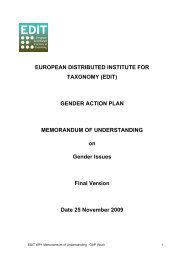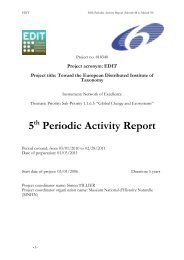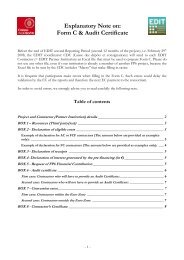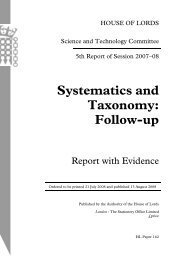Newsletter #5 - EDIT | - European Distributed Institute of Taxonomy
Newsletter #5 - EDIT | - European Distributed Institute of Taxonomy
Newsletter #5 - EDIT | - European Distributed Institute of Taxonomy
Create successful ePaper yourself
Turn your PDF publications into a flip-book with our unique Google optimized e-Paper software.
that there is a fair communication between the<br />
larger <strong>European</strong> initiatives, although this does<br />
notoriginatefromapredefinedstrategy.But<br />
and vision how to proceed biodiversity<br />
research is satisfactory established to allow for<br />
a common and cooperative approach.<br />
An example is suite <strong>of</strong> biodiversity<br />
informatics projects <strong>of</strong> BioCISE, BioCASE,<br />
ERMS, Euro+Med Plantbase, Fauna Europaea,<br />
Species 2000-Europe, ENBI and more to follow.<br />
Also SYNTHESYS project which followed<br />
theinteractionbetweenscientificcommunities<br />
projects individual institutes. Another<br />
example are the networks excellence<br />
MARBEF, AlterNET, <strong>EDIT</strong> with the other more<br />
or less related networks EurOCEANS and<br />
Marine Genomics. All initiatives were planned<br />
with mutual communication and have in part<br />
common memberships. Increasingly these<br />
projects and networks show how to build the<br />
fabric the much needed cooperation at the<br />
<strong>European</strong> scale.<br />
This still leaves the reader with the question<br />
how the major biodiversity projects are<br />
interrelated. This short article is not intended<br />
to explain all details, but will inform you about<br />
the presently most important ‘sister’ projects<br />
<strong>of</strong> <strong>EDIT</strong>: SYNTHESYS and LIFE WATCH.<br />
anumber<strong>of</strong>earlier«LargeScaleFacilities»<br />
The main objective <strong>of</strong> <strong>EDIT</strong> is typical for a<br />
network <strong>of</strong> excellence, which is to manage a<br />
process leading to the integration <strong>of</strong> <strong>European</strong><br />
taxonomic efforts to create a <strong>European</strong> virtual<br />
capacity for biodiversity conservation. This<br />
should result in common priorities, activities<br />
and procedures, to be agreed upon amongst<br />
the cooperating directors.<br />
In contrast the SYNTHESYS cooperative<br />
project (http://www.synthesys.info/) has<br />
the very concrete objective to increase the<br />
number <strong>of</strong> high quality visiting researchers in<br />
our collections, and to undertake supporting<br />
activities such as standards and best practices<br />
for collections care. The main focus is on the<br />
interests <strong>of</strong> visiting researchers by selecting<br />
the best ones and by providing top-services in<br />
the collection facilities.<br />
LIFE WATCH (http://www.lifewatch.eu/) is<br />
centrewithanincreasedscientificbasisand<br />
a relative young initiative <strong>of</strong> the cooperating<br />
networks as mentioned above, aiming at<br />
establishing a large-scale infrastructure for<br />
biodiversity research by bringing genomic,<br />
species and ecological data in a digital<br />
environment for analysis and modelling. It is<br />
presently entering in a (EU funded) preparatory<br />
phase to work towards agreement <strong>of</strong> a coalition<br />
<strong>of</strong> countries to start the actual construction<br />
and operations <strong>of</strong> the infrastructure.<br />
Although there clear differences between<br />
these activities, there are also important<br />
relations. SYNTHESYS shows how collection<br />
institutes can cooperate and its network<br />
activities feed in a number <strong>of</strong> <strong>EDIT</strong> work<br />
packages. Plus, the SYNTHESYS activities<br />
for developing best practice in collections<br />
care are assisted by <strong>EDIT</strong> with the broader<br />
implementation across <strong>European</strong> institutes.<br />
As such SYNTHESYS also contributes to LIFE<br />
WATCH, as its mechanisms for the selection<br />
and support <strong>of</strong> visiting researchers will<br />
contribute to designing the Service Centre<br />
<strong>of</strong> LIFE WATCH. Also <strong>EDIT</strong> will contribute to<br />
LIFE WATCH by focussing on data priorities,<br />
enabling technologies for data capture, and on<br />
the research agenda.<br />
Within these relationships the task <strong>of</strong> <strong>EDIT</strong><br />
is crucial. When the <strong>European</strong> taxonomic<br />
community wants to play a leading role in<br />
science and society <strong>of</strong> the 21st century it has<br />
to liaise with other disciplines and get a strong<br />
position in the new large initiatives. <strong>EDIT</strong> is the<br />
network cooperation that should result in the<br />
agreements and new work practices that will<br />
allow to play this collaborative leading role.<br />
18










